towing SATURN SKY 2007 Owners Manual
[x] Cancel search | Manufacturer: SATURN, Model Year: 2007, Model line: SKY, Model: SATURN SKY 2007Pages: 384, PDF Size: 2.47 MB
Page 1 of 384
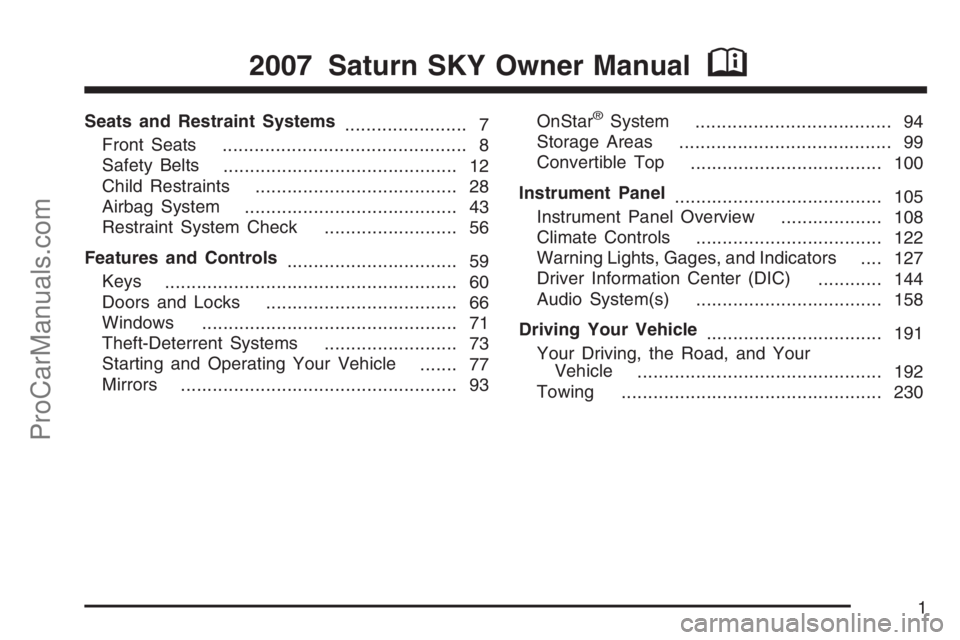
Seats and Restraint Systems
....................... 7
Front Seats
.............................................. 8
Safety Belts
............................................ 12
Child Restraints
...................................... 28
Airbag System
........................................ 43
Restraint System Check
......................... 56
Features and Controls
................................ 59
Keys
....................................................... 60
Doors and Locks
.................................... 66
Windows
................................................ 71
Theft-Deterrent Systems
......................... 73
Starting and Operating Your Vehicle
....... 77
Mirrors
.................................................... 93OnStar®System
..................................... 94
Storage Areas
........................................ 99
Convertible Top
.................................... 100
Instrument Panel
....................................... 105
Instrument Panel Overview
................... 108
Climate Controls
................................... 122
Warning Lights, Gages, and Indicators
.... 127
Driver Information Center (DIC)
............ 144
Audio System(s)
................................... 158
Driving Your Vehicle
................................. 191
Your Driving, the Road, and Your
Vehicle
.............................................. 192
Towing
................................................. 230
2007 Saturn SKY Owner ManualM
1
ProCarManuals.com
Page 134 of 384
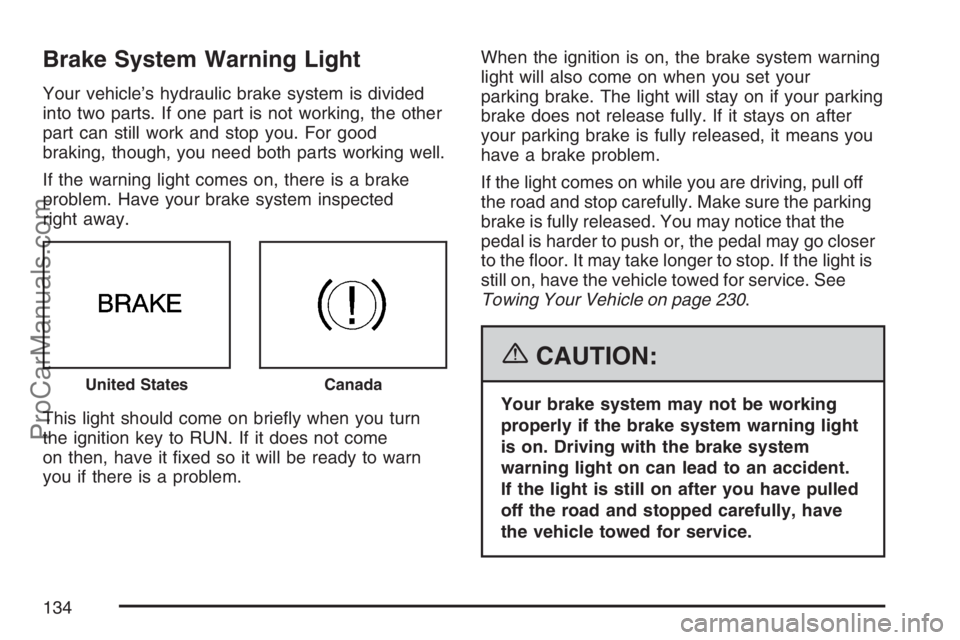
Brake System Warning Light
Your vehicle’s hydraulic brake system is divided
into two parts. If one part is not working, the other
part can still work and stop you. For good
braking, though, you need both parts working well.
If the warning light comes on, there is a brake
problem. Have your brake system inspected
right away.
This light should come on brie�y when you turn
the ignition key to RUN. If it does not come
on then, have it �xed so it will be ready to warn
you if there is a problem.When the ignition is on, the brake system warning
light will also come on when you set your
parking brake. The light will stay on if your parking
brake does not release fully. If it stays on after
your parking brake is fully released, it means you
have a brake problem.
If the light comes on while you are driving, pull off
the road and stop carefully. Make sure the parking
brake is fully released. You may notice that the
pedal is harder to push or, the pedal may go closer
to the �oor. It may take longer to stop. If the light is
still on, have the vehicle towed for service. See
Towing Your Vehicle on page 230.
{CAUTION:
Your brake system may not be working
properly if the brake system warning light
is on. Driving with the brake system
warning light on can lead to an accident.
If the light is still on after you have pulled
off the road and stopped carefully, have
the vehicle towed for service.
United StatesCanada
134
ProCarManuals.com
Page 191 of 384
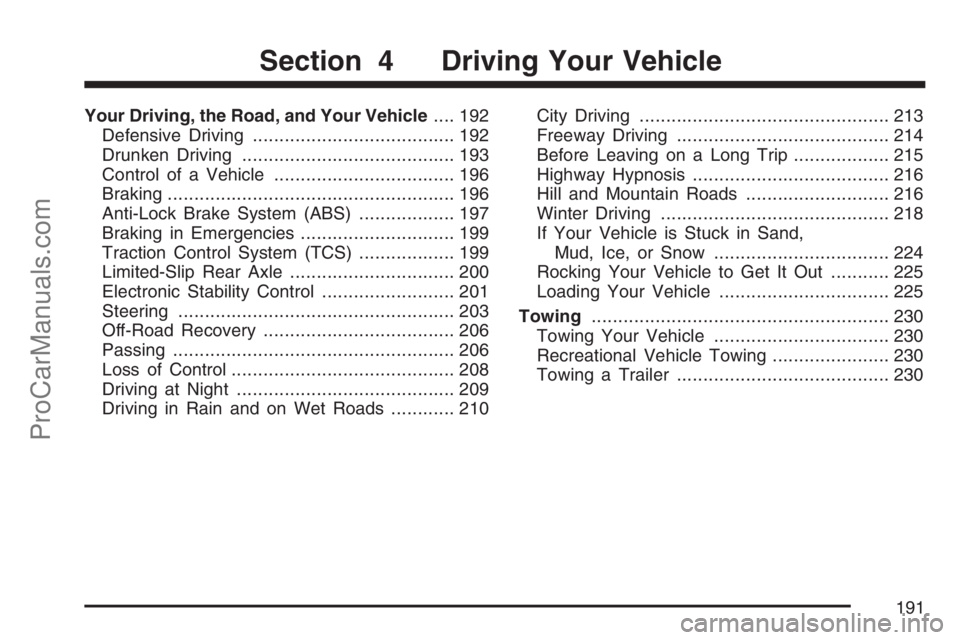
Your Driving, the Road, and Your Vehicle.... 192
Defensive Driving...................................... 192
Drunken Driving........................................ 193
Control of a Vehicle.................................. 196
Braking...................................................... 196
Anti-Lock Brake System (ABS).................. 197
Braking in Emergencies............................. 199
Traction Control System (TCS).................. 199
Limited-Slip Rear Axle............................... 200
Electronic Stability Control......................... 201
Steering.................................................... 203
Off-Road Recovery.................................... 206
Passing..................................................... 206
Loss of Control.......................................... 208
Driving at Night......................................... 209
Driving in Rain and on Wet Roads............ 210City Driving............................................... 213
Freeway Driving........................................ 214
Before Leaving on a Long Trip.................. 215
Highway Hypnosis..................................... 216
Hill and Mountain Roads........................... 216
Winter Driving........................................... 218
If Your Vehicle is Stuck in Sand,
Mud, Ice, or Snow ................................. 224
Rocking Your Vehicle to Get It Out........... 225
Loading Your Vehicle................................ 225
Towing........................................................ 230
Towing Your Vehicle ................................. 230
Recreational Vehicle Towing...................... 230
Towing a Trailer........................................ 230
Section 4 Driving Your Vehicle
191
ProCarManuals.com
Page 225 of 384
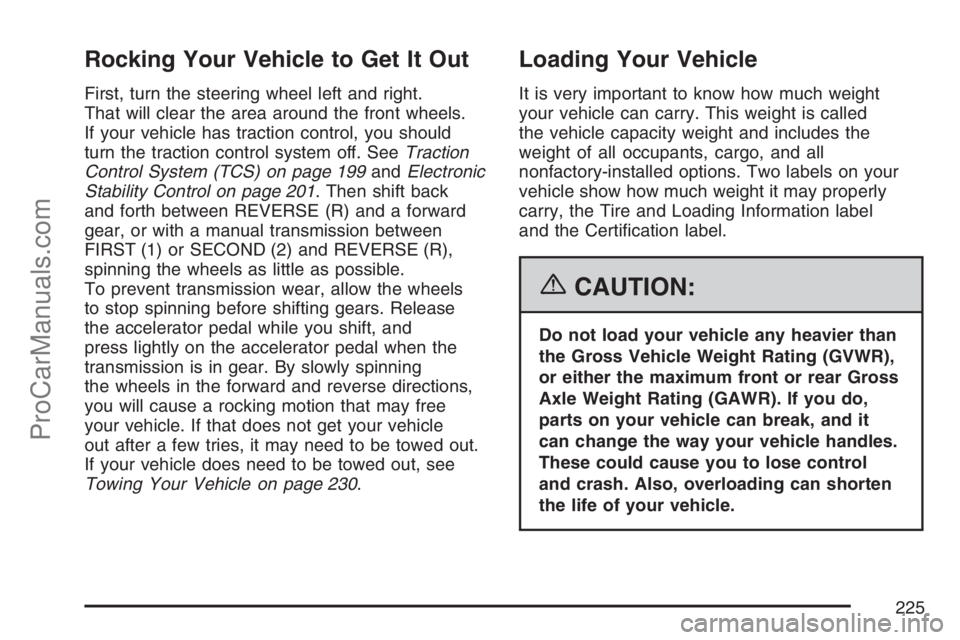
Rocking Your Vehicle to Get It Out
First, turn the steering wheel left and right.
That will clear the area around the front wheels.
If your vehicle has traction control, you should
turn the traction control system off. SeeTraction
Control System (TCS) on page 199andElectronic
Stability Control on page 201. Then shift back
and forth between REVERSE (R) and a forward
gear, or with a manual transmission between
FIRST (1) or SECOND (2) and REVERSE (R),
spinning the wheels as little as possible.
To prevent transmission wear, allow the wheels
to stop spinning before shifting gears. Release
the accelerator pedal while you shift, and
press lightly on the accelerator pedal when the
transmission is in gear. By slowly spinning
the wheels in the forward and reverse directions,
you will cause a rocking motion that may free
your vehicle. If that does not get your vehicle
out after a few tries, it may need to be towed out.
If your vehicle does need to be towed out, see
Towing Your Vehicle on page 230.
Loading Your Vehicle
It is very important to know how much weight
your vehicle can carry. This weight is called
the vehicle capacity weight and includes the
weight of all occupants, cargo, and all
nonfactory-installed options. Two labels on your
vehicle show how much weight it may properly
carry, the Tire and Loading Information label
and the Certi�cation label.
{CAUTION:
Do not load your vehicle any heavier than
the Gross Vehicle Weight Rating (GVWR),
or either the maximum front or rear Gross
Axle Weight Rating (GAWR). If you do,
parts on your vehicle can break, and it
can change the way your vehicle handles.
These could cause you to lose control
and crash. Also, overloading can shorten
the life of your vehicle.
225
ProCarManuals.com
Page 227 of 384
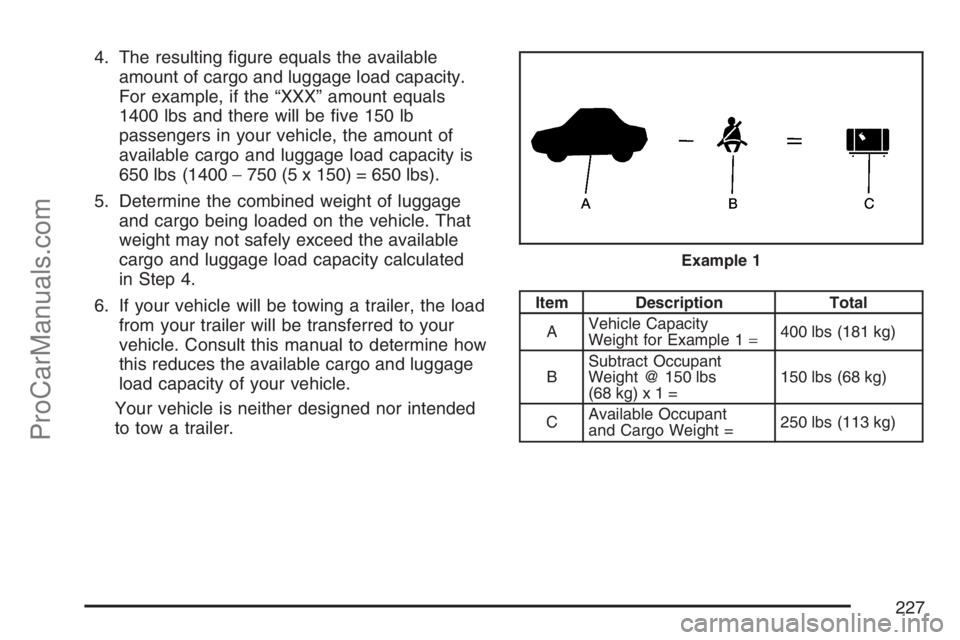
4. The resulting �gure equals the available
amount of cargo and luggage load capacity.
For example, if the “XXX” amount equals
1400 lbs and there will be �ve 150 lb
passengers in your vehicle, the amount of
available cargo and luggage load capacity is
650 lbs (1400−750 (5 x 150) = 650 lbs).
5. Determine the combined weight of luggage
and cargo being loaded on the vehicle. That
weight may not safely exceed the available
cargo and luggage load capacity calculated
in Step 4.
6. If your vehicle will be towing a trailer, the load
from your trailer will be transferred to your
vehicle. Consult this manual to determine how
this reduces the available cargo and luggage
load capacity of your vehicle.
Your vehicle is neither designed nor intended
to tow a trailer.
Item Description Total
AVehicle Capacity
Weight for Example 1=400 lbs (181 kg)
BSubtract Occupant
Weight @ 150 lbs
(68 kg) x 1 =150 lbs (68 kg)
CAvailable Occupant
and Cargo Weight =250 lbs (113 kg) Example 1
227
ProCarManuals.com
Page 230 of 384
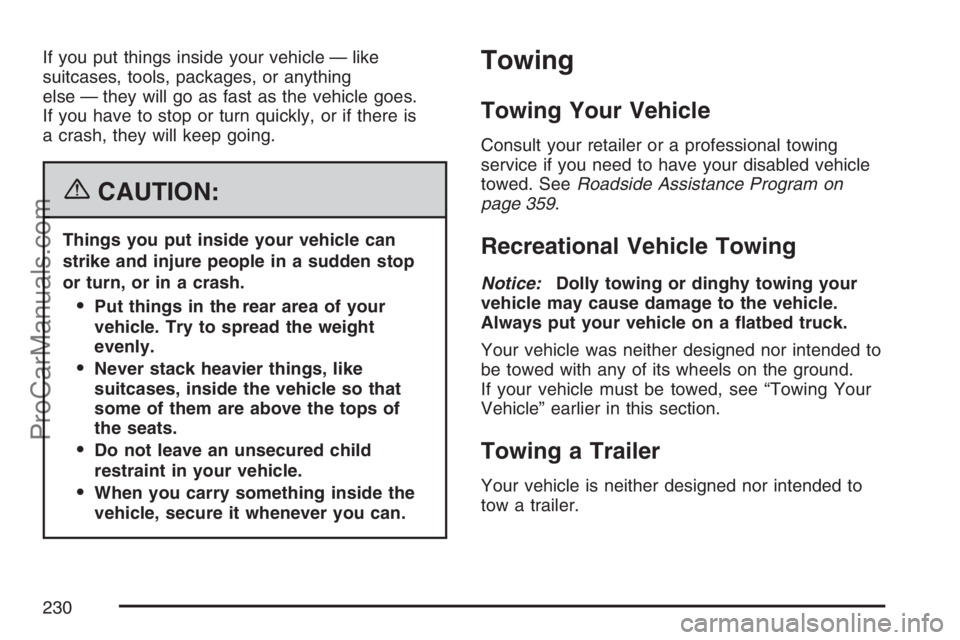
If you put things inside your vehicle — like
suitcases, tools, packages, or anything
else — they will go as fast as the vehicle goes.
If you have to stop or turn quickly, or if there is
a crash, they will keep going.
{CAUTION:
Things you put inside your vehicle can
strike and injure people in a sudden stop
or turn, or in a crash.
Put things in the rear area of your
vehicle. Try to spread the weight
evenly.
Never stack heavier things, like
suitcases, inside the vehicle so that
some of them are above the tops of
the seats.
Do not leave an unsecured child
restraint in your vehicle.
When you carry something inside the
vehicle, secure it whenever you can.
Towing
Towing Your Vehicle
Consult your retailer or a professional towing
service if you need to have your disabled vehicle
towed. SeeRoadside Assistance Program on
page 359.
Recreational Vehicle Towing
Notice:Dolly towing or dinghy towing your
vehicle may cause damage to the vehicle.
Always put your vehicle on a �atbed truck.
Your vehicle was neither designed nor intended to
be towed with any of its wheels on the ground.
If your vehicle must be towed, see “Towing Your
Vehicle” earlier in this section.
Towing a Trailer
Your vehicle is neither designed nor intended to
tow a trailer.
230
ProCarManuals.com
Page 362 of 384

For prompt and efficient assistance when calling,
please provide the following to the Roadside
Assistance Representatives:
Your name, home address, and home
telephone number
Telephone number of your location
Location of the vehicle
Model, year, color, and license plate number
Odometer reading, Vehicle Identi�cation
Number and delivery date of the vehicle
Description of the problem
While we hope you never have the occasion to
use our service, it is added security while traveling
for you and your family. Remember we are only
a phone call away. Saturn Roadside Assistance:
1-800-553-6000; text telephone (TTY) users,
call1-800-833-6000. Canadian customers
call1-800-268-6800.Saturn and General Motors of Canada Limited
reserve the right to limit services or reimbursement
to an owner or driver when, in their sole
discretion, the claims become excessive in
frequency or type of occurrence.
Roadside Assistance is not part of or included in
the coverage provided by the New Vehicle Limited
Warranty. Saturn and General Motors of Canada
Limited reserve the right to make any changes
or discontinue the Roadside Assistance program
at any time without noti�cation.Towing and Road Service Exclusions
Speci�cally excluded from Roadside Assistance
coverage are towing or services for vehicles
operated on a non-public roadway or highway,
�nes, impound towing caused by a violation
of local, Municipal, State, Provincial or Federal
law, and mounting, dismounting or changing
of snow tires, chains or other traction devices.
362
ProCarManuals.com
Page 366 of 384
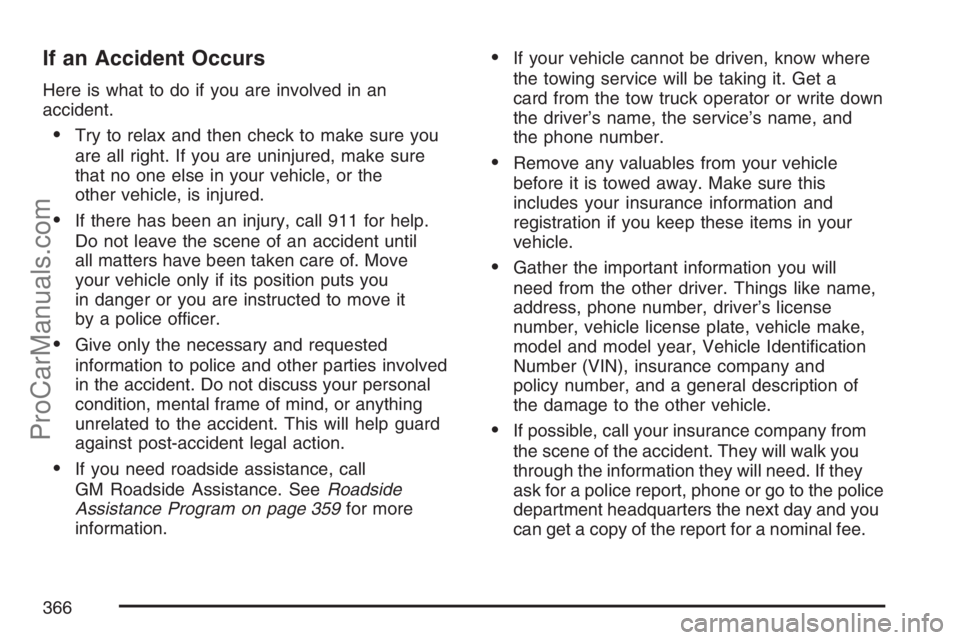
If an Accident Occurs
Here is what to do if you are involved in an
accident.
Try to relax and then check to make sure you
are all right. If you are uninjured, make sure
that no one else in your vehicle, or the
other vehicle, is injured.
If there has been an injury, call 911 for help.
Do not leave the scene of an accident until
all matters have been taken care of. Move
your vehicle only if its position puts you
in danger or you are instructed to move it
by a police officer.
Give only the necessary and requested
information to police and other parties involved
in the accident. Do not discuss your personal
condition, mental frame of mind, or anything
unrelated to the accident. This will help guard
against post-accident legal action.
If you need roadside assistance, call
GM Roadside Assistance. SeeRoadside
Assistance Program on page 359for more
information.
If your vehicle cannot be driven, know where
the towing service will be taking it. Get a
card from the tow truck operator or write down
the driver’s name, the service’s name, and
the phone number.
Remove any valuables from your vehicle
before it is towed away. Make sure this
includes your insurance information and
registration if you keep these items in your
vehicle.
Gather the important information you will
need from the other driver. Things like name,
address, phone number, driver’s license
number, vehicle license plate, vehicle make,
model and model year, Vehicle Identi�cation
Number (VIN), insurance company and
policy number, and a general description of
the damage to the other vehicle.
If possible, call your insurance company from
the scene of the accident. They will walk you
through the information they will need. If they
ask for a police report, phone or go to the police
department headquarters the next day and you
can get a copy of the report for a nominal fee.
366
ProCarManuals.com
Page 380 of 384

Passenger Airbag Status Indicator............... 131
Passenger Position, Safety Belts................... 27
Passenger Sensing System........................... 50
Passing....................................................... 206
PASS-Key
®III+............................................. 75
PASS-Key®III+ Operation............................. 75
Power
Accessory Outlet(s).................................. 121
Door Locks................................................ 67
Electrical System..................................... 325
Retained Accessory (RAP)......................... 79
Steering Fluid.......................................... 266
Windows.................................................... 72
Pretensioners, Safety Belt............................. 27
Q
Questions and Answers About Safety Belts ... 17
R
Radios........................................................ 158
Care of Your CD Player........................... 190
Care of Your CDs.................................... 190Radios (cont.)
Radio with CD................................162, 168
Setting the Time..............................159, 160
Theft-Deterrent......................................... 188
Understanding Reception ......................... 189
Rear Axle.................................................... 278
Limited-Slip.............................................. 200
Rearview Mirror with OnStar
®........................ 93
Rearview Mirrors........................................... 93
Reclining Seatbacks...................................... 10
Recommended Fluids and Lubricants.......... 345
Recreational Vehicle Towing........................ 230
Remote Keyless Entry (RKE) System............ 62
Remote Keyless Entry (RKE) System,
Operation................................................... 63
Replacement Bulbs..................................... 283
Reporting Safety Defects
Canadian Government............................. 368
Saturn...................................................... 369
United States Government....................... 368
Restraint System Check
Checking the Restraint Systems................. 56
Replacing Restraint System Parts
After a Crash......................................... 57
380
ProCarManuals.com
Page 382 of 384
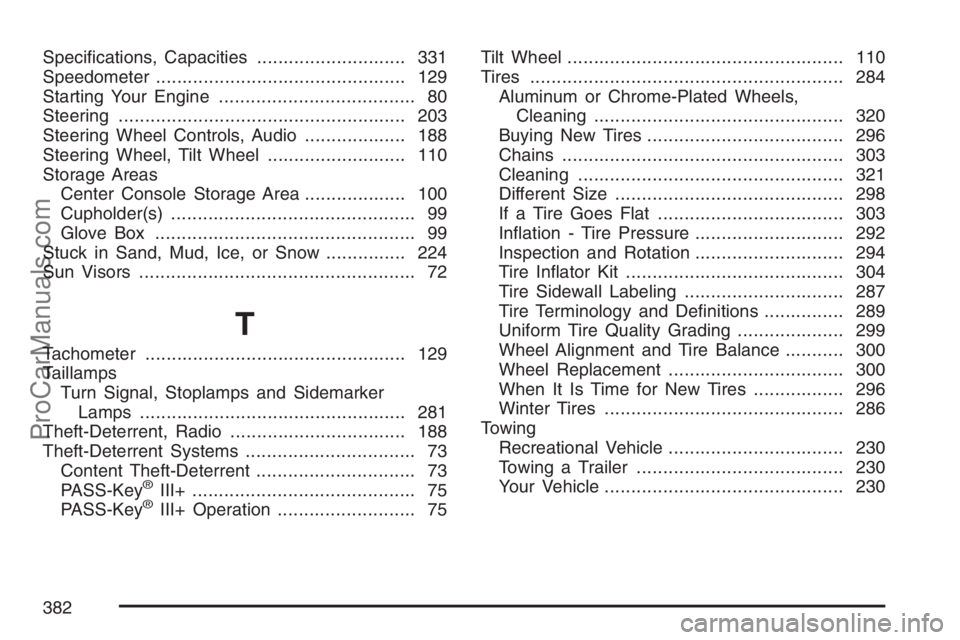
Speci�cations, Capacities............................ 331
Speedometer............................................... 129
Starting Your Engine..................................... 80
Steering...................................................... 203
Steering Wheel Controls, Audio................... 188
Steering Wheel, Tilt Wheel.......................... 110
Storage Areas
Center Console Storage Area................... 100
Cupholder(s).............................................. 99
Glove Box................................................. 99
Stuck in Sand, Mud, Ice, or Snow............... 224
Sun Visors.................................................... 72
T
Tachometer................................................. 129
Taillamps
Turn Signal, Stoplamps and Sidemarker
Lamps.................................................. 281
Theft-Deterrent, Radio................................. 188
Theft-Deterrent Systems................................ 73
Content Theft-Deterrent.............................. 73
PASS-Key
®III+.......................................... 75
PASS-Key®III+ Operation.......................... 75Tilt Wheel.................................................... 110
Tires........................................................... 284
Aluminum or Chrome-Plated Wheels,
Cleaning............................................... 320
Buying New Tires..................................... 296
Chains..................................................... 303
Cleaning.................................................. 321
Different Size........................................... 298
If a Tire Goes Flat................................... 303
In�ation - Tire Pressure............................ 292
Inspection and Rotation............................ 294
Tire In�ator Kit......................................... 304
Tire Sidewall Labeling.............................. 287
Tire Terminology and De�nitions............... 289
Uniform Tire Quality Grading.................... 299
Wheel Alignment and Tire Balance........... 300
Wheel Replacement................................. 300
When It Is Time for New Tires................. 296
Winter Tires............................................. 286
Towing
Recreational Vehicle................................. 230
Towing a Trailer....................................... 230
Your Vehicle............................................. 230
382
ProCarManuals.com